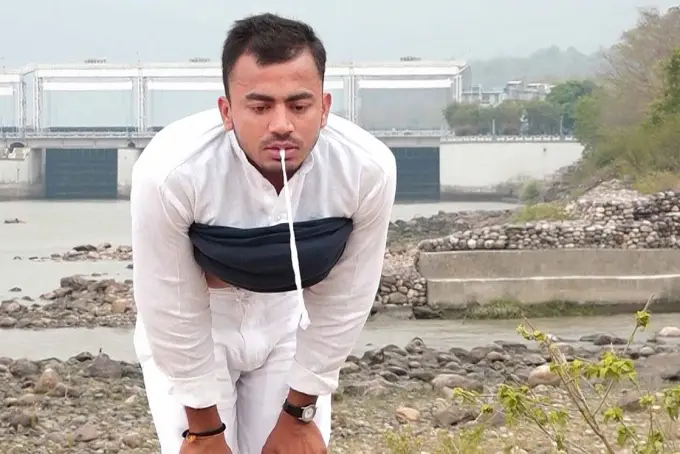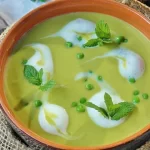Vastra Dhauti, one of six hatha yoga purification methods known as Shatkarma, is intended to cleanse the entire alimentary canal of pollutants. From the top of the mouth to the base of the rectum, various forms of Dhauti are employed for washing. Vastra Dhauti, which is a component of Hrid or Cardiac Dhauti, consists mostly of cleaning the upper stomach area to alleviate “Kapha” or phlegm-related issues.
The science of Vastra Dhauti
Three doshas—Kappa (phlegm), Pitta (bile), and Vata—are necessary for the internal organ system of the human body to function (wind). Any one of these three doshas out of equilibrium causes physical limitations or illnesses.
The food and beverages we consume also produce trash, some of which might become lodged in the Oesophagus (gullet). This waste material keeps building up over time and transforms into phlegm and mucus. During a terrible cold, the effects of mucus can be felt in the body, while phlegm is expelled by coughing or wheezing. This causes an imbalance in the “Kapha dosha” due to the excessive buildup of these waste products in the body.
Vastra Dhauti is used to maintain extra gastric juice discharges and eliminate mucus that is obstructing the respiratory passages. This restores the equilibrium of the Kapha Dosha in the body and heals all skin conditions, common illnesses, and respiratory issues.
Vastra Dhauti: A Detailed Explanation
As the name of every other posture in yoga, the name ‘Vastra’ is also taken from the Sanskrit language. Vastra means ‘A Piece of Cloth’ & Dhauti is referred here to as ‘Cleansing’. This practice is pretty much like Vamana Dhauti, except that here a Vastra (A Piece of Cloth) is used in place of water.
Theoretically, verse 2.24 of the ancient yogic text “Hatha Yoga Pradipika” is where the practice of Vastra Dhauti is first introduced. In the Vastra Dhauti technique, a piece of loosely woven, damp cotton cloth is ingested into the stomach. Several abdominal movements (Nauli) are carried out after the cloth has been entirely swallowed into the stomach. After that, the stomach is cleaned by carefully removing the towel.
Vastra Dhauti cloth
Swallowing a cloth into the stomach could be quite difficult for the seeker if some defects are there in the cloth. Therefore following parameters should be kept in mind while performing Vastra Dhauti.
- The dimension of Vastra Dhauti Cloth
Length – 20 to 25 feet, Width – 2 to 3 inches (Less than the width of the tongue) - The cloth used in this practice should be made up of finely woven cotton, not a synthetic material.
- All the corners of the cloth should be neatly trimmed so that no fraying takes place.
How to do Vastra Dhauti: A step-by-step guide
- Preparing a water solution for cloth
- Swallowing the cloth
- Performing abdominal movements (Nauli)
- Pulling cloth out
Step – 1 – Preparing a water solution for cloth
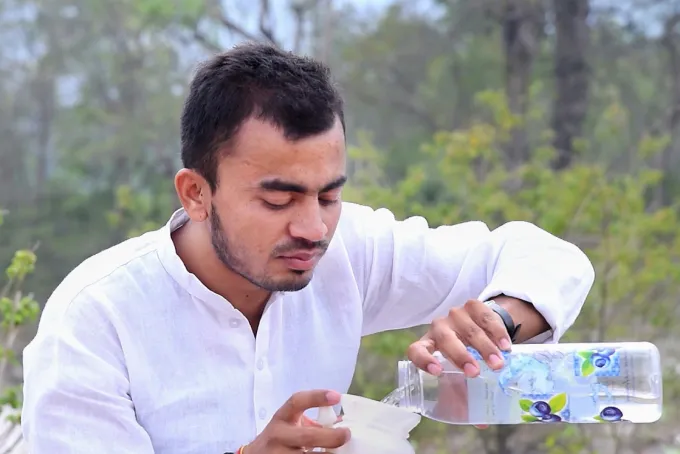
Prepare a basin or kettle of warm water and add two tablespoons of salt to every liter of water. Since saltwater won’t likely be absorbed by the fragile blood vessels, it is prepared. As normal water is heavily absorbed by the cells, it might cause cells to shrink or bulge out.
Grab a long piece of cotton fabric and fully submerge one end of it in the warm, salty water. Additionally, keep a glass of warm water nearby so you may take little sips while swallowing.
Step – 2 – Swallowing the cloth
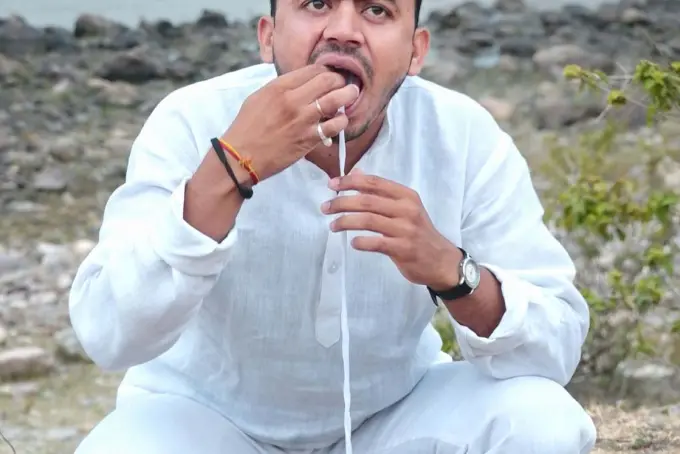
- Sit in the squat position with a relaxed body (Utkatasana) – The buttocks are either elevated or lying on a block with the heels on the ground. If it is more comfortable, one can also sit in Sukhasana with the back straight.
Spread the cloth’s widest point over the tongue now, tucking the other end into the basin. - Hold the cloth’s upper end close to your mouth and begin to slowly swallow the damp fabric. The practitioner can take a tiny drink of water if the cloth gets stuck in their throat while they are swallowing.
- When the cloth has almost entirely been ingested, get up and work on your stomach muscles. Make sure there is around half a foot of material hanging outside so that it may be removed after practice.
NOTE : [Do not drink a large quantity of water to swallow the cloth. The stomach should be filled up with a cloth, not drinking water.]
Step – 3 – Performing Abdominal Movements (Nauli)

- Now in this stage, the cloth is completely inside the stomach. To make sure effective cleansing, some movements are performed in the stomach. This practice is called Nauli.
- Move the stomach right to left, left to right one by one, and then rotate it in a circular motion. This practice could be difficult for beginners so one can simply churn the stomach side by side.
- 5-10 minutes is sufficient time for cleansing the whole stomach, although one can leave the cloth inside for a maximum of up to 20 minutes. If the cloth is kept for more than 20 minutes in the stomach, the cloth will automatically slide into the small intestine by the regular movements in the stomach.
Step – 4 – Pulling the cloth out
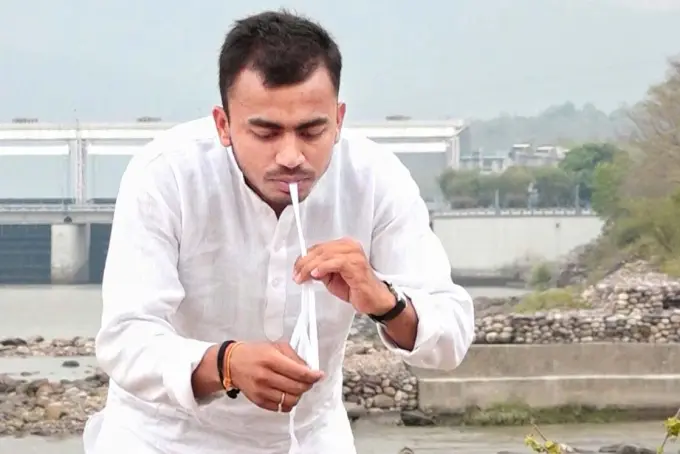
Resuming the squatting stance, grab the dangling end of the fabric to pull it out. Start carefully removing cloth outdoors now. The inner lining of the intestinal tract’s mucous and sticky substance is evident on the cloth. To use cloth the following time, simply wash and disinfect the item.
Benefits of Vastra Dhauti
All food and drink enter the body through the stomach, where they are absorbed and ultimately converted into energy that keeps us healthy. Food is somehow impacted if the route it takes to reach the stomach (esophagus) is not clean, which has an impact on our health.
There are the following health benefits of Vastra Dhauti.
- The Vastra Dhauti cleanses the esophagus of mucus and other sticky materials. Now that food won’t build on the route to the stomach, it alleviates asthma, phlegm, and cough-related problems.
- Different types of yogic breathing (Pranayama) need the use of the throat region, hence before beginning these pranayamas, the throat can be cleared using Vastra Dhauti.
- Since all of the body’s energy passes via the stomach, how it functions can have an impact on a variety of skin conditions. Vastra Dhauti purges the stomach of toxins that have become lodged there and helps treat skin conditions like acne and itching.
- The digestive tract, liver, and spleen all function more efficiently when the stomach is healthy and clean. Vastra Dhauti can thereby ease problems connected to gas, acidity, and indigestion.
- The Manipura chakra, which is responsible for increasing the practitioner’s digestive fire, is opened by the Vastra Dhauti practice.
- Regular and steady Vastra Dhauti practice bolsters the respiratory system’s organs. Additionally, it aids in immune system maintenance.
Beginner Tips to do Vastra Dhauti
- Since it won’t be completely swallowed on the first try, beginners should practice swallowing cloth gradually over several days. This is how it should be ingested.
Day one: 1 to 2 feet
Day two: 3 to 4.5 feet
On the third day, 5 to 7 feet are swallowed, and so on until 22 feet have been consumed. - At this moment, fight the impulse to throw up. The fabric tends to stick somewhere near the lowest point of the throat. The urge to vomit will subside as the cloth descends a little farther toward the esophagus.
- At this moment, fight the impulse to throw up. The fabric tends to stick somewhere near the lowest point of the throat. The urge to vomit will subside as the cloth descends a little farther toward the esophagus.
- If you always feel the want to throw up as you’re swallowing, dab a little honey on the damp cloth.
- After unwinding in savasana while engaging in Vastra Dhauti practice, one can consume milk and rice pudding.
Vastra Dhauti Precautions
- Cloth (Vastra) should be continuous without any joints. The stitching of the Dhauti cloth should be proper and good.
- There should not be any cut, loose thread, torn, or other damage in the cloth as it may remain inside the stomach or injure the delicate esophagus and stomach walls.
- The cloth should be washed by hand using very soft soap if required. Don’t use a brush.
- Cloth can be used according to one’s practice for three months. But, when you find it not suitable better get new cloth.
- Don’t put the cloth in boiling water, the cloth may get damaged. So put it in warm water.
- The time allowed for the whole process should not be more than 20 to 25 minutes in total as it is quite likely that the pyloric end of the stomach may open and a part of the Dhauti cloth may pass into the duodenum. Then it is difficult to take it out, as it will be caught at the other end of the stomach. Force might tear the Dhauti cloth or harm the tissues making them bleed.
- One must reserve one to two feet of the Dhauti cloth outside for bringing it out.
- One should not pull the cloth forcefully when it is caught firmly due to vigorous contraction of the muscles of the esophagus or cardiac sphincter. Take rest for a while, drink some water, and swallow some more length of cloth; when muscles relax bring out the cloth softly.
- The cloth should be washed, dried, and kept in a closed container.
- It should not be practiced in front of the public.
- The time duration for the whole practice should not exceed more than 20 – 25 minutes.
For Patients:
Respiratory System:
- In order to expel the sputum from the chest, the esophageal action—Dhautis in general and Vastra and Danda Dhautis in particular while they are traveling through the esophagus—reflects on the trachea.
- Particularly in asthma, these bronchial walls contract and mucus pellets obstruct the airway’s outward passage, creating a one-way valve. Bronchial asthma is brought on by smooth muscle contraction, edema, and mucus in the lumen (space of the internal tube structure) of the bronchi and bronchioles. Asthma can also be brought on by allergic reactions to dust, wheat, and other allergens.
Digestive System:
The fluids accumulated in the stomach are absorbed by the cotton fabric of the Vastra Dhauti. A light massage is performed by softly rubbing the cloth across the stomach. In Dhauti, a lot of mucus and bile is released.
Blood and food particles have occasionally been discovered as well. Gastric juices and peristaltic motions are increased, and extra mucus coating is eliminated. The stomach and esophagus are cleansed and stimulated by Dhauti. The body is cleansed of excess bile, phlegm, and other pollutants.
Mental Health:
Dhauti has an influence on individuals in a positive manner so that the overall system and the personality as a whole could become less irritable to the external and internal stimuli and could develop better endurance to pain. Duties are indirectly helping to cure mental illnesses like neurosis, anxiety, and depression.
Contra-Indications:
- Do not practice when there is an injury in the pharynx, esophagus, and stomach.
- Should not be attempted by those who are suffering from a hernia, severe abdominal and chest pain, headache, fever, high blood pressure (HBP), heart problems, any serious digestive disorder, and acute condition of any diseases.
- Ladies should not practice during menses and pregnancy.
- It should only be used to get relief from hyperacidity as it stimulates gastric juices.
















